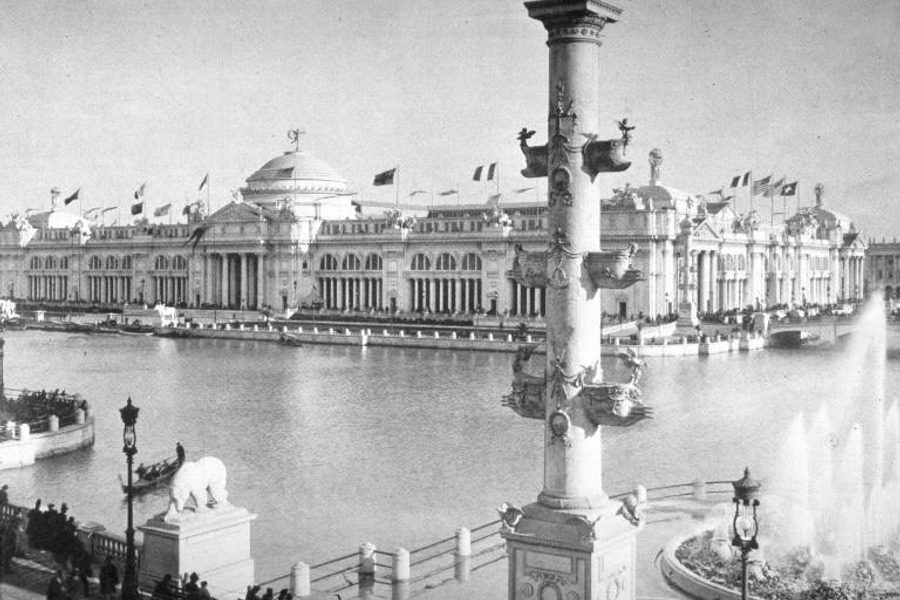
The 2003 book Devil in the White City is known as a gripping and exhaustively-researched tale of the famous 1893 Columbian Exposition in Chicago, telling the parallel tales of the architectural genius and vision of Exposition developer Daniel Burnham and the suave sadism of H.H. Holmes, a serial killer who operated with impunity during the fair.
But a lesser-known and also intriguing and chilling theme woven throughout the book is the brutality and lethality of being a blue-collar worker in Chicago in those days, especially one of the thousands of workers engaged for three years in building the Exposition’s “White City.”
Author Erik Larson notes that “scores of workers had been hurt or killed in building the dream, their families consigned to poverty.” Along with the scores of workers who flocked to Chicago specifically for work building the massive and temporary fair buildings, the exposition would never have happened without the other thousands of hardworking Chicagoans laboring in the city’s famous and infamous foundries, stockyards and other industries.
Larson describes the Union Stockyards that employed 25,000 men, women and children killing 14 million animals a year – toiling amidst a nearly unbearable stench of incinerated hair and burned flesh. The conditions in the stockyards are well-known, thanks in part to Upton Sinclair’s The Jungle.
But without dwelling on or emphasizing daily indignities and cruelties, Larson’s sensory portrait of the hardscrabble, filthy, ever-striving city also offers numerous glimpses of many other grueling jobs that made Chicago tick; and what it was like to be a working person trying to scrape by.
For example, the workers tasked with descending many feet into swampy ground constructing shafts to support the weight of skyscrapers and bridges. These shafts had to be filled with highly pressurized air lest the walls cave in. Hence workers in these shafts would get the bends, an excruciatingly painful and often deadly experience.
This technique was used to build the bridge across the Mississippi River in St. Louis in the mid-1800s, and Larson notes that of the 352 workers employed on one side of the bridge, 12 were killed by pressure-related illness, two were crippled and 66 others were injured.
The murderer Holmes had an ample source of victims because so many young women were flowing into the city, drawn by the promise of independence and excitement facilitated by readily available jobs. Even the vast majority who did not meet a grisly end in his Englewood mansion faced hard lives rife with long grueling hours and sexual harassment at work. Larson notes the armies of young female typewriters and stenographers, in their standard white blouses and black skirts, responding to advertisements from often less-than-honorable employers specifically seeking attractive blondes.
Then there were the cab drivers, negotiating filthy, rutted streets in their horse-drawn carriages lit by gas lamps, plodding through crowds as sewage oozed up through the paving stones like pus, in Larson’s words. Horses would sometimes get spooked and rampage through crowds, trampling people and maybe throwing their drivers.
Then there were the workers who spent their lives shoveling coal into steam engines, as electricity was still almost a novelty in these days. The Fair faced many hurdles, to put it lightly, with various factors each on their own nearly dooming it to failure. Among these factors were the increasingly assertive demands of the labor unions, who recognized their power because fair planners, including the legendary Burnham, were absolutely dependent on them to make the fair a reality on a tight deadline.
Organizer Samuel Gompers was a frequent visitor. While Larson does a compelling job of depicting the everyday realities and struggles of workers, a cohesive description of the role of organized labor is noticeably missing – labor is dramatically but briefly alluded to though never fleshed out, a strange situation given the prominent role of unions, the colorful union leaders involved and the fact that this was all happening less than a decade after the Haymarket Affair.
Larson’s drawn-out description of the fair’s end is especially moving – the paroxysms of romanticism, unexpected flashes of tragedy including the assassination of populist mayor Carter Harrison, and also the cutting loose of thousands of suddenly unemployed workers left to roam the streets penniless as their handiwork crumbles into decline or goes up in flames.
Larson quotes novelist Robert Herrick, writing: “The poor had come lean and hungry out of the terrible winter that followed the World’s Fair…Tens of thousands of human beings, lured to the festive city by abnormal wages, had been left stranded, without food or a right to shelter in its tenant-less buildings…Heights of splendor, pride, exaltation in one month; depths of wretchedness, suffering, hunger, cold in the next.”
Kari Lydersen is a Chicago-based journalist, author and assistant professor at Northwestern University, where she leads the investigative specialization at the Medill School of Journalism, Media, Integrated Marketing Communications. Her books include Mayor 1%: Rahm Emanuel and the Rise of Chicago’s 99%.








